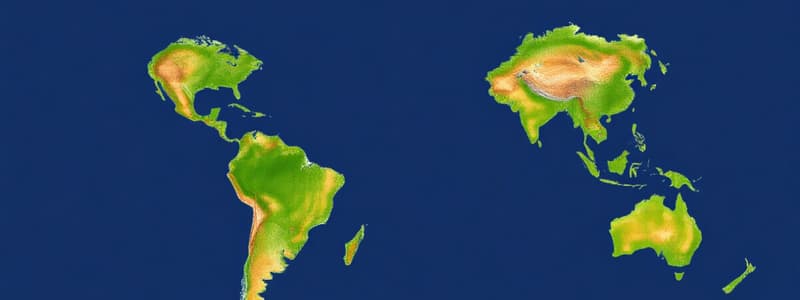Podcast
Questions and Answers
A country experiences a surge in citizens leaving to seek better economic opportunities abroad, while simultaneously experiencing a smaller influx of foreign workers. Which of the following accurately describes this scenario, and what is its likely impact on the country's population?
A country experiences a surge in citizens leaving to seek better economic opportunities abroad, while simultaneously experiencing a smaller influx of foreign workers. Which of the following accurately describes this scenario, and what is its likely impact on the country's population?
- Predominantly regional migration, causing shifts within the country's population distribution but not affecting overall numbers.
- Balanced net migration, resulting in a stable population.
- High emigration rate, potentially leading to a population decline or slower growth. (correct)
- High immigration rate, leading to a population increase.
A large corporation decides to relocate its headquarters from a major city to a more rural area, prompting many of its employees to move as well. What type of migration is this, and what are its potential socio-economic consequences for both the urban and rural areas involved?
A large corporation decides to relocate its headquarters from a major city to a more rural area, prompting many of its employees to move as well. What type of migration is this, and what are its potential socio-economic consequences for both the urban and rural areas involved?
- Involuntary migration; displacement of urban populations, increased social unrest in rural areas.
- International migration; cultural enrichment in both areas, potential strain on social services.
- Rural-urban migration; increased strain on urban infrastructure, decreased economic activity in rural areas.
- Urban-rural migration; potential revitalization of rural economies, decreased demand for housing and services in urban areas. (correct)
A sudden environmental disaster, such as a severe drought, forces a large number of farmers and their families to abandon their agricultural lands and seek refuge in neighboring regions. Which type of migration is exemplified in this situation, and what are its ethical implications for the areas receiving these migrants?
A sudden environmental disaster, such as a severe drought, forces a large number of farmers and their families to abandon their agricultural lands and seek refuge in neighboring regions. Which type of migration is exemplified in this situation, and what are its ethical implications for the areas receiving these migrants?
- Involuntary migration; ethical obligations for receiving areas to provide humanitarian assistance and protection. (correct)
- Voluntary migration; minimal ethical implications as migrants are making a choice.
- Regional migration; primarily economic implications for the receiving regions.
- International migration; significant legal and political implications related to border control.
Consider a country where the number of people immigrating is significantly higher than the number of people emigrating. Analyze the potential long-term effects of this net migration pattern on the country's demographic structure, economic growth, and social integration.
Consider a country where the number of people immigrating is significantly higher than the number of people emigrating. Analyze the potential long-term effects of this net migration pattern on the country's demographic structure, economic growth, and social integration.
Several interrelated factors can influence a person's decision to migrate. Evaluate which combination of factors would most likely result in a sustained, large-scale international migration flow from a developing country to a developed one.
Several interrelated factors can influence a person's decision to migrate. Evaluate which combination of factors would most likely result in a sustained, large-scale international migration flow from a developing country to a developed one.
Flashcards
Migration
Migration
Movement of people from one place to another due to environmental, economic, or social factors.
Immigration
Immigration
The act of coming to live permanently in a foreign country.
Emigration
Emigration
The act of leaving one's own country to settle permanently in another.
Net Migration
Net Migration
Signup and view all the flashcards
Rural-Urban Migration
Rural-Urban Migration
Signup and view all the flashcards
Study Notes
- Migration is the movement of people from one place to another.
- Migration is often driven by environmental changes or economic opportunities.
- Immigration is the act of settling permanently in a foreign country.
- Emigration is the act of leaving one's country to settle permanently elsewhere.
- Net migration is the difference between the number of immigrants and emigrants.
- Rural to urban migration happens when people relocate from rural areas to urban areas either temporarily or permanently.
- Urban to rural migration happens when people move away from urban areas to rural regions because of rapid urbanization challenges like pollution, traffic and poor housing.
- Voluntary migration happens when an individual chooses to leave their home.
- Involuntary migration is when foreign-born people migrate.
- Regional migration refers to the movement of people from one region to another within a country.
- International migration is the movement of people across international borders for settlement.
Studying That Suits You
Use AI to generate personalized quizzes and flashcards to suit your learning preferences.




